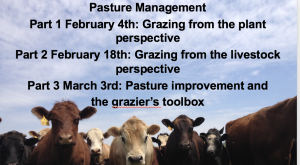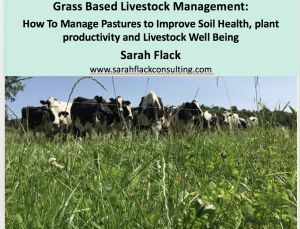Videos, Webinars & Podcasts
Scroll down this page for links to free videos, pod casts and webinars which can help you learn more about grazing management.
Podcasts:
The Ruminant: Rotational grazing tips with Sarah Flack
Webinars & Videos:
These are webinars in a three part series recorded in February and March 2020. Part one is an introduction to grazing management from the plants perspective.
Part two is looking at grazing systems from the livestock perspective.
Part three is the grazier’s tool box – putting it all together
Grass Fed Dairy Farming – Opportunities and Challenges in the rapidly growing market of 100% grass fed milk.
Preventing Pasture Problems on the Organic Dairy
Video: Calculating Dry Matter Intake in Organic Pastures Using a Pasture Stick
My name is Sarah Flack and I’m a grazing consultant. And today I’m going to show you how to use this grazing stick to measure the amount of dry matter that is available in a pasture for your livestock to graze. This is called a grazing stick or a pasture stick. They are usually made by NRCS or another local organization in your state, and these are one of the simplest ways to be able to go out into a pasture, look at how tall the grass is and also look at the density of the grass and figure out how many pounds of dry matter per acre is actually available for the livestock to graze. So the first thing you do to use this stick is you use the numbers on the side to measure about how tall the pasture plants are, and you’ll do this by actually walking around the whole pasture and taking measurements in several different areas. So if I did this here and I walked around this pasture, we’d probably say that this pasture is on average about 9 or 10 inches of height. I’m not measuring these seed heads because those are really not the grazeable forage; the animals are really going to eat the clover and the leafy grass blades down here. So that’s what I’m measuring here. So if we say this is about 9 inches of height, that’s the first step in using this grazing stick. The grazing stick has all of the instructions written right on it and so you can just follow along. And so the first step, after you’ve measured the height is to subtract 3 inches from that height and that’s so you are taking off the 2 to 3 inches that the animals aren’t going to eat and you are not including that part. So if said that was 9 inches of height, we’re going to take the 3 inches off and we’re saying that there is actually 6 inches of grazeable height in the pasture available for them to eat. The next part of using the grazing stick is figuring out what the density of the pasture is. So there’s a grid on the side of the grazing stick with a bunch of dots in it. And the way you use this part of it is you actually slide the stick right down on the soil surface with the dots up. So now that we’ve slid the grazing stick right down on the soil surface under the pasture plants, I’m going to stand and look straight down on the grazing stick and count how many dots that I can see. And I’m going to do this without moving my head so I can get a good objective measurement of how many I see. So I’m seeing 3 from where I’m standing here. So this gives us an estimate of the density of the plants in the pasture. So now that we have figured out how many dots we can see when this was underneath the pasture, we’re going to go over to this section right here that will tell us how many pounds per acre inch of dry matter is available based on how many dots we saw. So we’re going to use this third column because we saw 3 or more dots and this tells you based on the type of plant species in the pasture how many acre inches or pounds per acre inch there are. We’re going to go down to orchard grass and clover because a lot of this pasture is orchard grass with red clover and white clover. And we saw 3 dots so we’re going to go down to the column on the far side here and it’s telling there are 150 to 200 pounds of dry matter per inch in an acre out here. And so if we think back to the height measurement that we did, there were 6 inches available for grazing after we subtracted the 3 inches from the 9 inches we measured using the grazing stick. So we take that six inches and multiply it times, we’ll use this number 200, the higher number in the range, the 6 inches times (x) 200 pounds means that there is 1200 pounds of dry matter available here in each acre for the animals to graze. So now this stick has told us that there is about 1200 pounds of dry matter available in each acre for the animals to actually graze, and that’s assuming that the whole pasture looked like this area, we’re doing this for example purposes, and this is telling you the grazeable amount of dry matter per acre not the total amount of dry matter per acre available because the animals are going to eat about half of what’s here and they are going to leave the other half behind in little clumps that they reject and don’t want to eat. The other thing you always want to make sure when you are using any one of the many methods for measuring the amount of dry matter available per acre is to make sure that you check yourself and that you don’t have a really high number or a really low number; it’s often useful to go to some pasture walks or discussion group meetings, practice doing this with other farmers who have some experience with it so that when you get a number from the stick then you can look at the pasture and feel confident that you really did get an accurate number. And right here, I feel like this would be a pretty accurate number if I got 1200 pounds and the whole pasture looked like this, I think that is what would be available for grazing.
Calculating Paddock Size
Learn from grazing expert and organic certification consultant Sarah Flack as she demonstrates how to calculate dry matter intake of organic pastures using a pasture stick.
Learning from Our Observations of Pastures & Livestock: Preventing Pasture Problems on the Organic Dairy Webinar by eOrganic
All organic dairy farmers know the importance of pasture as the primary feed source for their cattle. But part of managing pastures well is honing our observation skills to assess what the plants and animals are telling us about their health. In this webinar, presented by grazing and organic certification specialist Sarah Flack, we will review the key grazing principles that help your cattle maximize dry matter intake from pastures and avoid potential problems. We will also look at examples of how to observe the livestock, their manure, soils and pasture plants to determine how well your pasture management system is working.
Creating a Grazing Map in Accordance with the New Access to Pasture Rule
Setting Up a Grazing System on Your Organic Dairy Farm Webinar by eOrganic
How to Calculate Pasture Dry Matter Intake on Your Organic Dairy Farm Webinar by eOrganic
On February 12, 2010, the USDA National Organic Program (NOP) published a final rule that establishes pasture standards for organic livestock. The Access to Pasture rule specifies that organic milk and meat products come from organically-raised animals that are actively grazing on pasture. The rule requires that these animals’ diets consist of at least 30% dry matter intake from pasture grazed during grazing season, and that the grazing season is at least 120 days. But how do you, as an organic dairy farmer, determine how much dry matter is coming from your pastures? This webinar, given by Sarah Flack, will help you predict the dry matter demand (DMD) of your animals, and walk you through the steps of determining dry matter intake (DMI) from different types of feed, especially from pasture; as well as help you calculate the percent DMI from pasture.

